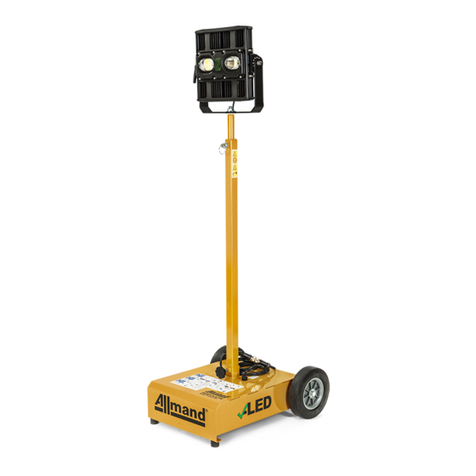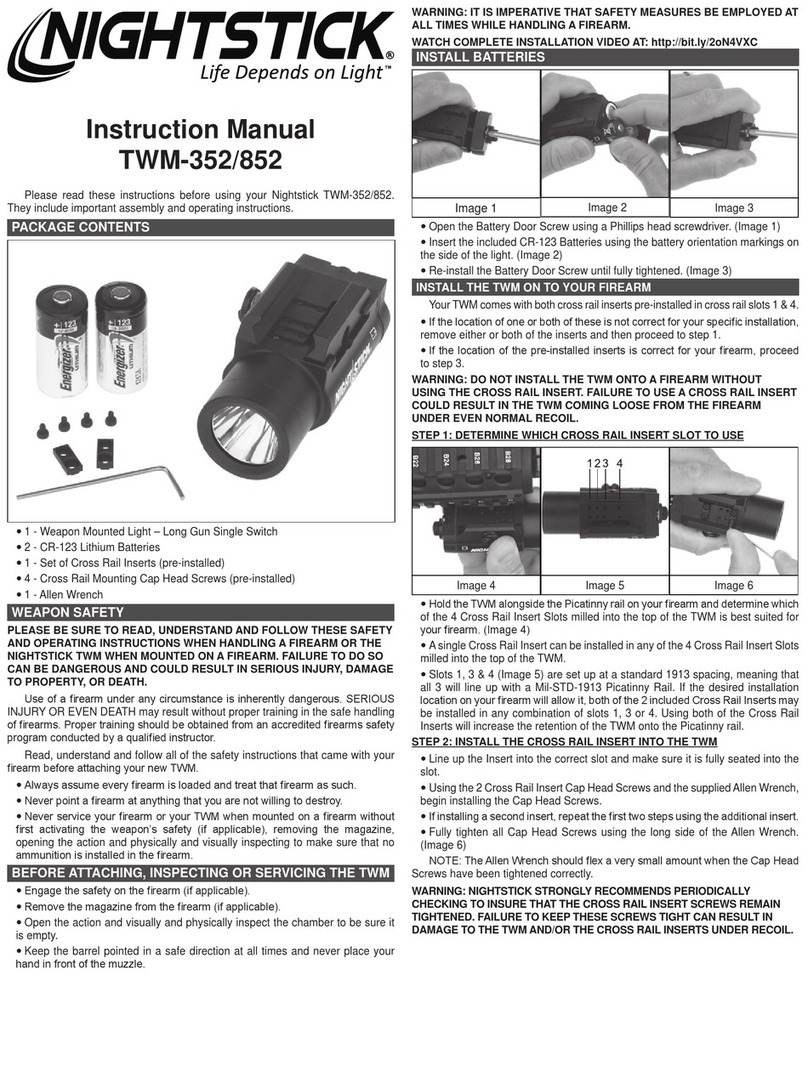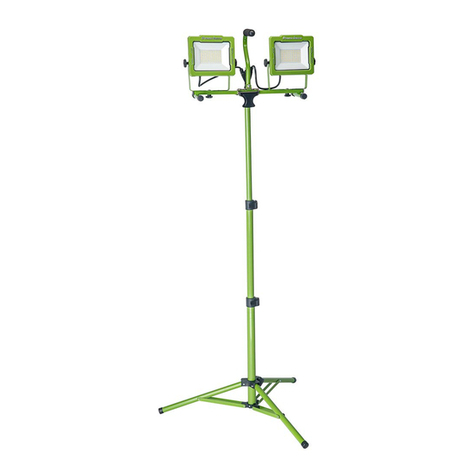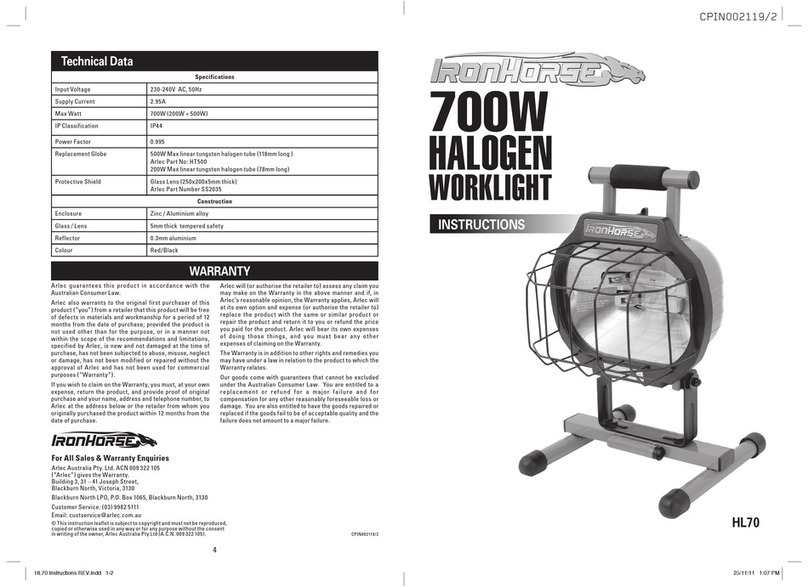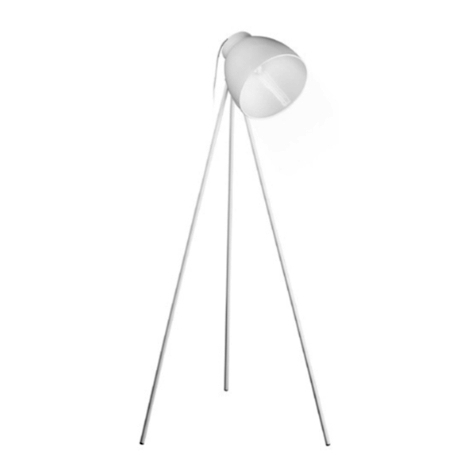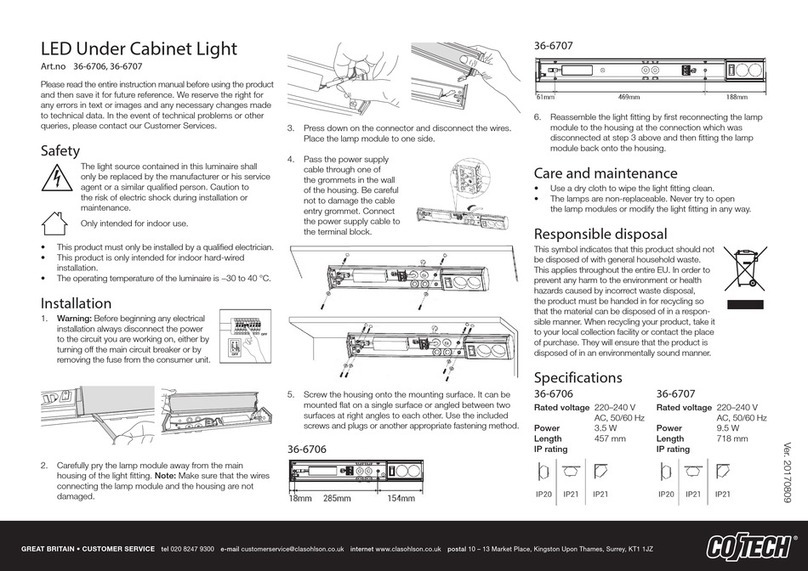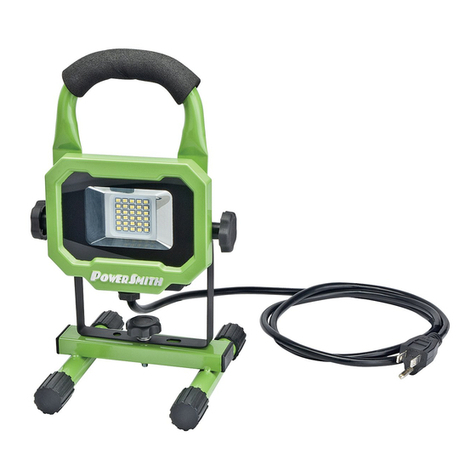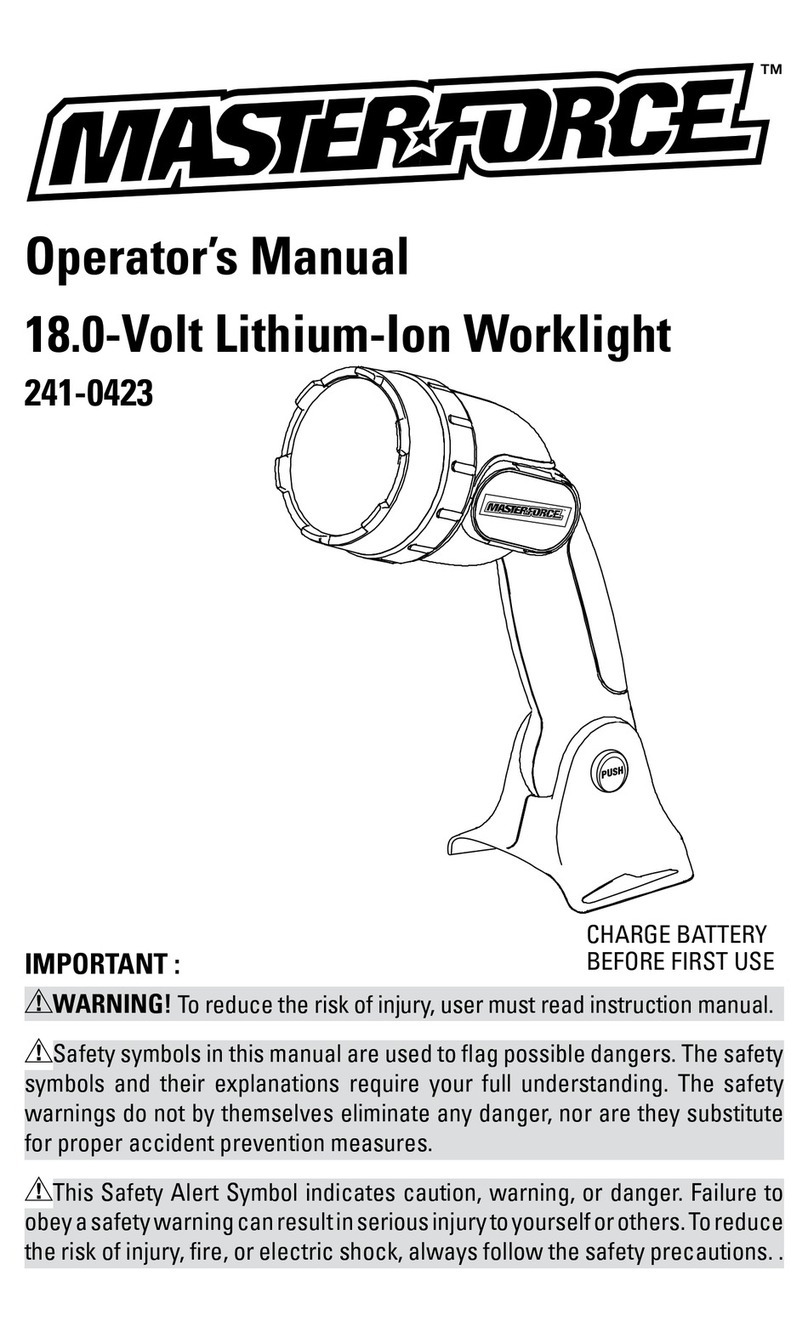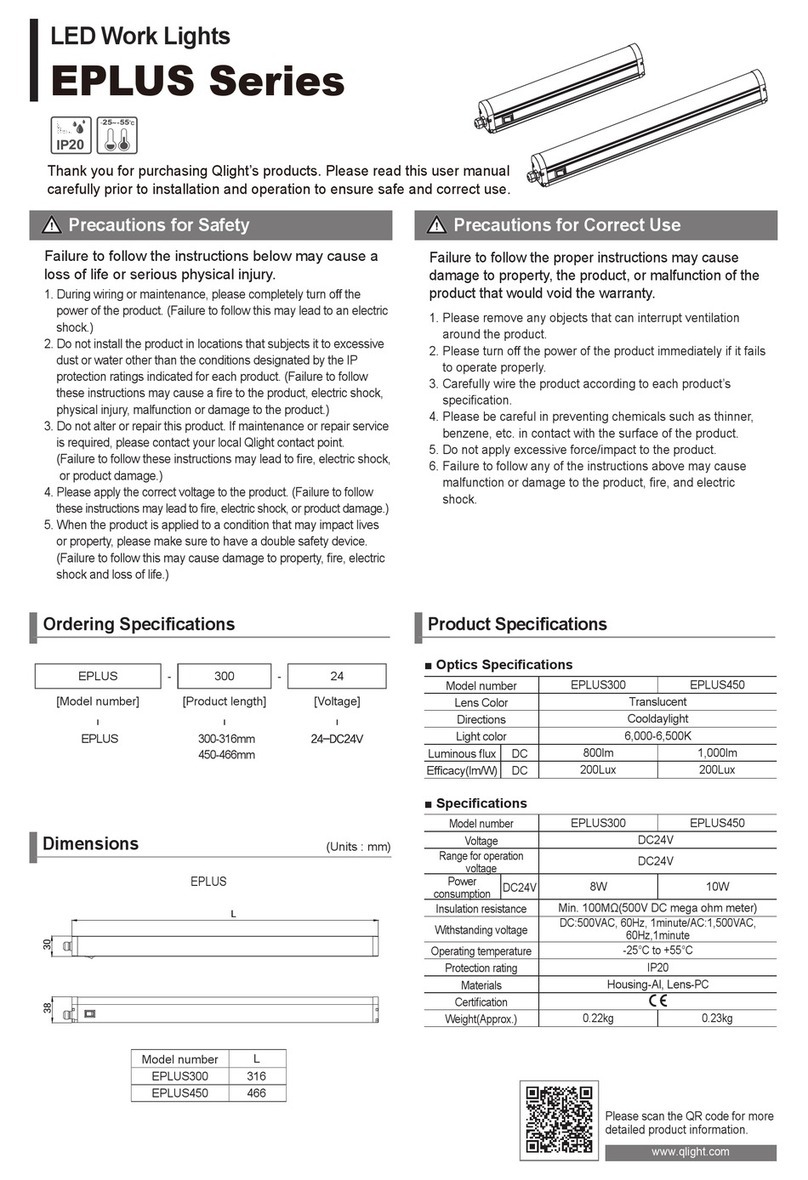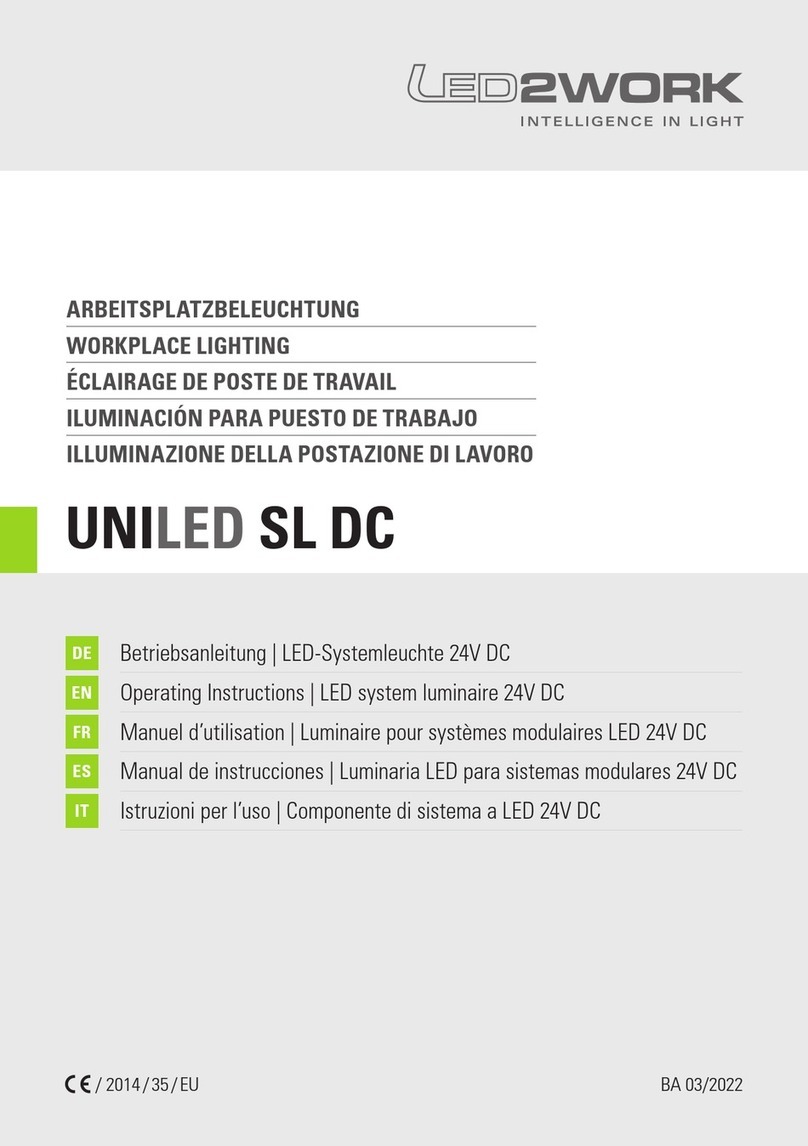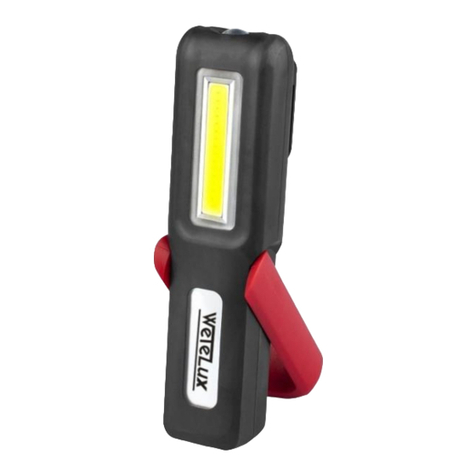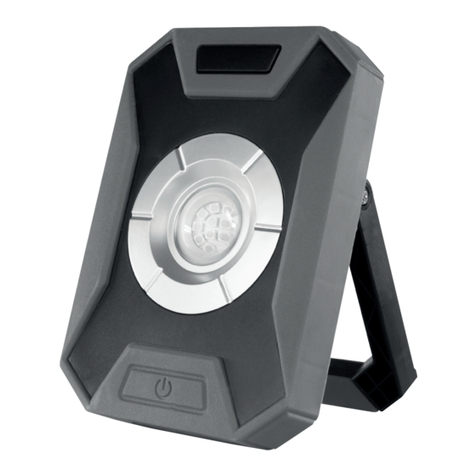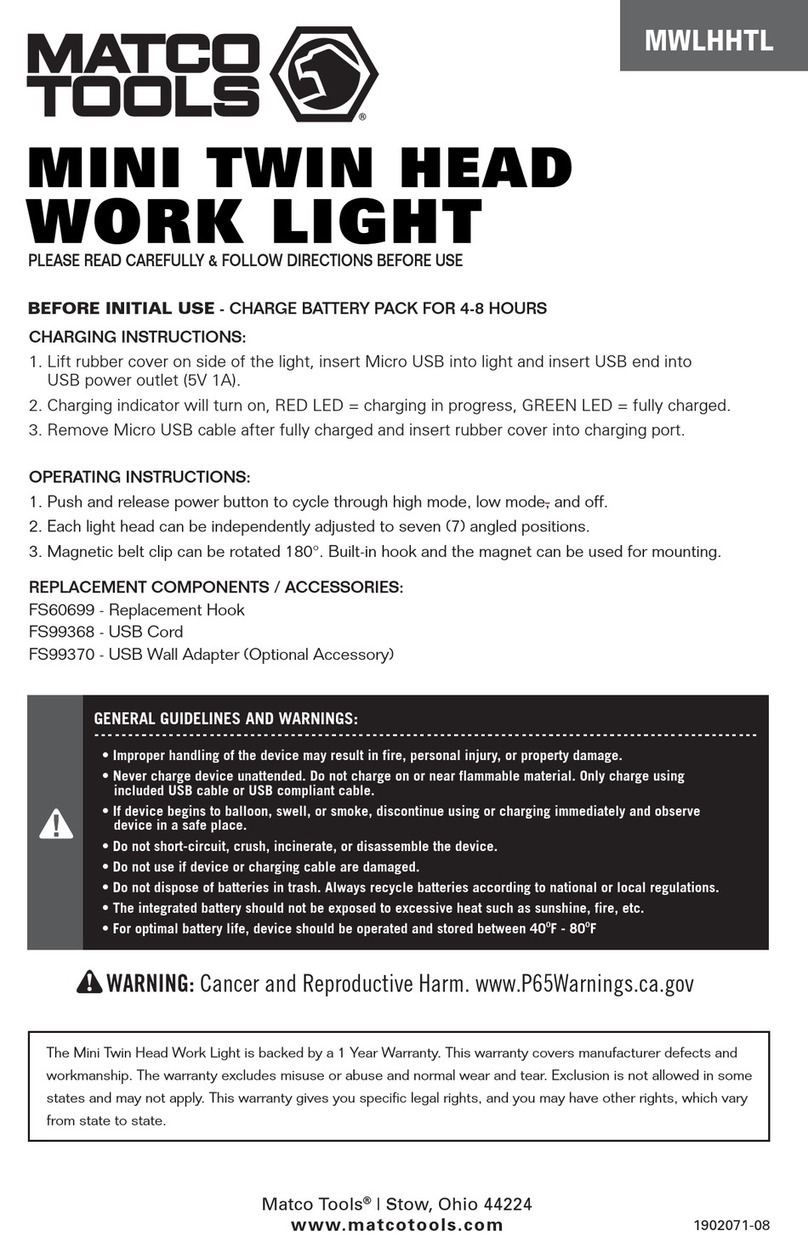Allmand Port-A-Lite PAL Single LED Series User manual

Not for
Reproduction

Not for
Reproduction
2
Products Covered by This
Manual
The following products are covered by this manual:
PAL50 Single LED, PAL60 Single LED
Manual Contents:
Introduction........................................................................... 2
Safety......................................................................................2
Features and Controls..........................................................5
Set-Up.....................................................................................6
Operation............................................................................... 6
Maintenance...........................................................................9
Troubleshooting.................................................................... 9
Specifications........................................................................9
Wiring Diagrams................................................................. 11
Introduction
About This Manual
TAKE TIME TO READ THIS MANUAL THOROUGHLY
This instruction manual provides necessary instructions
for the Allmand® PAL50 Single LED, PAL60 Single LED
Portable Work Light.
The information found in this manual is in effect at the time
of printing. Allmand Bros Inc. may change contents without
notice and without incurring obligation.
The images throughout this manual are representative, and
may differ from your model.
Any reference in this manual to left or right shall be
determined by looking at the trailer from the rear.
If uncertain about any of the information in the
manual, contact the Allmand service department at
1-800-562-1373, or contact us through the Allmand website,
www.allmand.com.
Save these original instructions for future reference.
Safety
Safety Definitions
For your safety, the safety of others, and to protect the
performance of equipment, follow the precautions listed
throughout the manual before operation, during operation and
during periodic maintenance procedures.
Indicates a potential personal injury hazard.
DANGER
Indicates a hazardous situation which, if not avoided, will
result in death or serious injury.
WARNING
Indicates a hazardous situation which, if not avoided, could
result in death or serious injury.
CAUTION
Indicates a hazardous situation which, if not avoided, could
result in minor or moderate injury.
NOTICE
Information considered important but not hazard related.
Safety Precautions
The following section contains general safety precautions
and guidelines that must be followed to reduce risk to
personal safety. Special safety precautions are listed in
specific procedures. Read, understand and obey all of the
safety precautions before operating or performing repairs or
maintenance.
DANGER
Electrocution Hazard
• Always place the portable work light on a dry surface
and away from areas where water might flow or
accumulate.
• Do not stand on a wet surface or in water when
connecting the portable work light to a power source
such as a wall outlet or power generator, or when
operating the light switch.
• Always check for overhead wires or obstructions before
raising or lowering the mast.
• Always follow the rules or instructions for your work
site and state, province and national electric code for
maintaining a safe distance from overhead wires.
• High voltage is present when the unit is plugged into
a power source. Never attempt to service electrical
components while the portable work light is connected
to a power source.
• Do not operate the portable work light if the insulation
on the power cord or other electrical wiring is cut or
worn, or if bare wires are exposed. Repair or replace
damaged wiring before connecting to a power source.
WARNING
Unsafe Operation Hazard
• Never permit anyone to operate the equipment without
proper training.
• Read and understand this Operator’s Manual before
operating or servicing the work light to ensure that safe
operating practices and maintenance procedures are
followed.
• Safety signs and decals are additional reminders for
safe operating and maintenance techniques.

Not for
Reproduction
3
WARNING
Modification Hazard
• Never modify the equipment without written consent of
the manufacturer. Any modification can effect the safe
operation of the equipment.
WARNING
Rollover Hazard
• Do not raise, lower or use the work light unless
positioned on firm ground.
• Never move or reposition the work light while the mast
is fully extended.
WARNING
Burn Hazard
• Light fixtures become very hot during operation and
shortly after shutdown.
• Handle hot components, such as light fixtures, with heat
resistant gloves.
NOTICE
• Any part which is found defective as a result of
inspection or any part whose measured value does not
satisfy the standard or limit MUST be replaced.
• Always tighten components to the specified torque.
Loose parts can cause equipment damage or cause it
to operate improperly.
•The use of authorized Allmand®replacement parts is
encouraged. The warranty does not cover damage or
performance problems caused by the use of parts that
are not authorized replacement parts.
• Clean all accumulated dirt and debris away from the
body of the equipment and its components before
you inspect the equipment or perform preventative
maintenance procedures or repairs. Operating
equipment with accumulated dirt and debris will cause
premature wear of equipment components.
• Retrieve any tools or parts that may have dropped
inside of the equipment to avoid improper equipment
operation.
Safety Decals
Before operating your unit, read and understand the following
safety decals. The cautions, warnings and instructions are for
your safety. To avoid personal injury or damage to the unit,
understand and obey all the decals.
Keep the decals from becoming dirty or torn, and replace
them if they are lost or damaged. Also, if a part needs to be
replaced that has a decal attached to it, make sure to order
the part and decal at the same time.
Compare Figure1with the tables following.
1
Domestic / CSA Models

Not for
Reproduction
4
A DANGER
Electrocution Hazard.
Entering electrical
compartment while
equipment is in operation
will result in death or serious
injury. Shut down equipment
before entering electrical
compartment.
Part No. 116372
B WARNING
Unsafe Operation
Hazard.
Looking at illuminated
light fixtures could result in
serious injury. Do not look
directly at illuminated light
fixtures.
Burn Hazard.
Handling light fixtures when
they are hot could result
in serious injury. Keep
clear of light fixtures when
illuminated or hot.
Part No. 116370
C Suitable for damp locations
Part No. 116160
International Models
A DANGER
Electrocution Hazard.
Entering electrical
compartment while
equipment is operating
will result in death or
serious injury. Shut down
equipment and read manual
before entering electrical
compartment.
Part No. 104480
B WARNING
Unsafe Operation
Hazard.
Looking at illuminated
light fixtures could result in
serious injury. Never look
directly at illuminated light
fixtures.
Burn Hazard.
Handling light fixtures when
hot could result in death or
serious injury. Always keep
clear of light fixtures when
illuminated or hot.
Part No. 108011
All Models
D Operating Instructions
Part No. 112145
E Light On / Off
Part No. 108012
Operation Icons
The following table contains safety and operation icons that
may be found on the unit, along with the meaning of each
icon.
Icon Meaning
Unit Check

Not for
Reproduction
5
Icon Meaning
Unit Operation
Unit Shutdown
Work Light
Power On
Power Off
Features and Controls
Allmand®Port-A-Lite®PAL Single LED portable work lights
are intended for use as a stationary light source. They may
be used indoors on dry surfaces, and may be used outdoors
on dry surfaces and in weather conditions when wind or
precipitation are not present.
The Allmand®Port-A-Lite®PAL Single LED portable work
lights require an external power source and may be plugged
into a wall outlet or portable generator.
Identify the features and controls of the machine by
comparing Figure2with the table following.
2
Ref Description
A LED Light Fixture
B Fixture Yoke
C Fixture Handle Nut (Locking Pin on some models)
D Fixture Cable
E Inner Mast
F Latch Spring Pin
G Outer Mast
H Base Cable
I Power Cord

Not for
Reproduction
6
Ref Description
J Cable Tie
K Mast Socket Knob
L Base Assembly
M Power Switch
Set-Up
Preparing For Set-Up
Allmand® Port-A-Lite® PAL LED portable work lights are
shipped in separate cartons, and require assembly before
use. Upon receiving the unit, remove each piece from
the shipping cartons and inspect the parts for damage.
Contact your dealer or Allmand if parts were damaged during
shipping.
Set-Up Instructions
1. Loosen the mast socket knob (A, Figure 3).
2. Insert the outer mast (B, Figure 3) in the socket, and
tighten the knob.
3. Make sure the inner mast (C, Figure 3) is completely
lowered, and that the latch spring pin (D) is engaged in
the hole in the inner mast.
4. Place the center hole of the fixture yoke (E, Figure 3)
onto the stud on the inner mast, and secure with the
plastic washer (F), flat washer (G) and jam nut (H). Do
not overtighten.
5. Remove the cable tie (I, Figure 3) from the base cable (J).
6. Connect the base cable to the fixture cable (K, Figure 3).
3
Operation
Preparing The Unit For Use
WARNING
Unsafe Operation Hazard.
Operating the unit with worn, damaged or missing parts
can result in death or serious injury. Always replace worn,
damaged or missing parts promptly. Do not operate this
unit until all worn, damaged or missing parts have been
replaced, and proper operation of unit has been verified.

Not for
Reproduction
7
NOTICE
We encourage the use of authorized Allmand®replacement
parts. The warranty does not cover damage or performance
problems caused by the use of parts that are not authorized
replacement parts.
1. Check that a copy of the Operator's Manual is with the
unit.
2. Check that all safety decals are legible and in place on
the unit. SeeSafety Decalsin theSafetysection of
this manual.
3. Check the unit for proper operation. (SeeOperating The
Unitfor detailed information on operating procedures.)
• Check that the inner mast extends and retracts
properly, and that inner mast can be locked in each
height position with the latch spring pin.
• Check that the LED fixture hardware is tightened.
• Check that the power cord, base cable and fixture
cable are not frayed or damaged, and that the
connectors are not damaged.
• Check that the mast socket knob securing the outer
mast to the base assembly is tightened.
• Check the condition of the wheels, and that they roll
freely.
4. Plug the power cord into a wall outlet or power generator.
SeeSpecificationsfor detailed information on power
requirements.
5. Turn the power switch to the ON position to check the
LED fixture. SeeTroubleshootingif the LED fixture
does not light. When finished, set the power switch to the
OFF position and disconnect the power cord from the wall
outlet or power generator.
Work Site Considerations
Prior to setting up and operating the work light, the operator
must determine where to place it on the work site. It is the
operator's responsibility to ensure that the work light is
properly and safely positioned on at the work site. Be sure to
follow rules or instructions for your work site, and any state,
province and federal rules that may apply.
Overhead Obstructions
Always keep well clear of any overhead power wires. Make
sure there are no overhead obstructions where you intend to
place the portable work light. Keep clear of any loose cables,
ropes or obstructions that could ensnare the mast or LED
fixture. When the mast is fully elevated, the portable work
light stands 9.6 feet (2.9 m) from ground level to the top of the
LED fixture.
DANGER
Electrocution Hazard.
Contact with overhead electrical wires will result in death
or serious injury. Always follow the rules or instructions for
your work site, and the state, province and federal rules for
maintaining a safe distance from overhead wires.
Wetness & Wind
The portable work light must be placed on a dry surface away
from areas that might become wet.
WARNING
Shock Hazard.
Positioning a portable work light on a wet surface or in
water will result in death or serious injury. Always position
the work light on a dry surface away from areas where
water may flow or accumulate.
Do not set up the work light in an area where winds exceed
10 mph (16 km/h).
WARNING
Unsafe Operation Hazard.
Operating the portable work light with the mast fully
elevated in winds exceeding 10 mph (16 km/h) can cause
work light tip over resulting in death or serious injury.
Always fully lower the mast when winds are expected to
exceed 10 mph (16 km/h).

Not for
Reproduction
8
Work Surface
The portable work light must be placed on a firm, stable
surface capable of supporting the total weight of the work
light. The surface should be level, and must not exceed a
grade of 5% (2.8° incline) in any direction.
WARNING
Rollover / Tipover Hazard.
Positioning the portable work light on soft or unstable
ground could cause work light rollover resulting in death or
serious injury. Always position the work light on a firm, level
and stable surface.
Operating The Unit
To Operate The Unit
1. Connect the LED fixture.
Loosen the cable tie. Connect the base cable to the
fixture cable.
2. Position the LED fixture.
The LED fixture may be rotated left / right, and up /
down.
3. Raise the mast to the desired height.
1. Pull the latch spring pin and rotate it 90°.
2. Raise the inner mast to the desired height. There are
four holes in the inner mast that may be used.
3. Rotate the latch spring pin 90° and engage one of
the four holes in the inner mast. Be sure the latch
spring pin is fully seated in the hole.
4. Connect the power cord and turn on the work light.
1. Connect the power cord to a wall outlet or power
generator.
Note:If an extension cord is required, use an extension
cord rated for the current required by the work light.
SeeSpecificationsfor detailed information on power
requirements.
2. Move the power switch to the ON position.
To Shut Down The Unit

Not for
Reproduction
9
1. Shut off the work light and disconnect the power
cord.
1. Move the power switch to the Off position.
2. Disconnect the power cord from the wall outlet or
power generator.
2. Lower the mast.
1. Hold the inner mast, then pull the latch spring pin
and rotate it 90°.
2. Fully lower the inner mast.
3. Rotate the latch spring pin 90° and engage the hole
in the inner mast. Be sure the latch spring pin is fully
seated in the hole.
Maintenance
General Maintenance
WARNING
Shock Hazard.
Contact with high voltage could result in death or serious
injury. Turn off the unit and disconnect the power cord
before you do maintenance.
Burn Hazard.
Contact with hot surfaces could result in death or serious
injury. Wait 10 minutes after turning the unit off before you
do maintenance.
• Make sure that the unit is in good operating condition.
See Preparing the Unit for Use .
• Make sure that no components are missing, worn or
damaged.
WARNING
Do not operate the unit with missing, worn or damaged
components. Death or serious injury could result. Contact
your authorized dealer for service.
• Make sure that all the hardware on the unit is tight.
• Wipe down the unit with a damp cloth to remove dust, dirt
and debris.
• Occasionally apply a small amount of grease to the
wheels.
Location of Serial Number Plate
The serial number plate for the work light is located on the
end of the base near the power switch.
Location of Weight and Power
Information
Information on the weight of the work light is located on top
of the base near the mast.
Information on the electrical requirements for the work light
is located on top of the base near the mast and next to the
weight decal.
Troubleshooting
Problem Possible Cause
1. Unit not plugged in. Plug unit into power source.
2. Power switch turned off. Turn power switch to ON.
3. Base cable not connected to fixture cable. Connect base
cable to fixture cable.
No light
4. Unit malfunction. Contact authorized dealer.
Specifications
Dimensions
Description In Cm
Overall Length 28.7 72.8
Overall Width 24.5 62.2

Not for
Reproduction
10
Description In Cm
Overall Height (Fully Lowered) 6.0 (ft) 1.8 (m)
Overall Height (Fully Extended) 9.6 (ft) 2.9 (m)
Weight
Description Lb Kg
Overall 124 56.2
Base 85 38.6
Mast 20 9.1
Light Fixture 19 8.6
Power Requirement
Description PAL50
Single
LED
PAL60
Single
LED
Frequency - Hertz 50 60
Volts 220 120
Amps 3.5 3.5

Not for
Reproduction
11
Wiring Diagrams
PAL50 Single LED
PAL50 Single LED
A 16 Amp 250V Schuko Male Plug
B 14/3 Cord
C White - 14 AWG
D Black - 14 AWG
E Green - 14 AWG
F 15 Amp DPST Switch
G AC Ground
H Blue
I Brown
J Green w/Yellow Stripe
K LED Driver
L ACN
M ACL
N Ground
O 2-Gang Terminal Strip
P Black
Q White
RGreen
S 16/3 Cord
T 4-Pin Female Quick Connector
U 4-Pin Male Quick Connector
V LED Cord
W #1 LED Light
PAL60 Single LED

Not for
Reproduction
12
PAL 1250 SHO
A 120V Male Plug
B 14/3 Cord
C White - 14 AWG
D Black - 14 AWG
E Green - 14 AWG
F 15 Amp DPST Switch
G AC Ground
H Blue
I Brown
J Green w/Yellow Stripe
K LED Driver
L ACN
M ACL
N Ground
O 2-Gang Terminal Strip
P Black
Q White
RGreen
S 16/3 Cord
T 4-Pin Female Quick Connector
U 4-Pin Male Quick Connector
V LED Cord
W #1 LED Light

Not for
Reproduction
13
Productos cubiertos por este
manual
Los siguientes productos se cubren en este manual:
PAL50 Single LED, PAL60 Single LED
Índice de contenidos:
Introducción.........................................................................13
Seguridad.............................................................................13
Características y controles................................................16
Instalación............................................................................17
Operación.............................................................................18
Mantenimiento.....................................................................21
Resolución de problemas.................................................. 21
Especificaciones................................................................. 21
Diagramas de cableado......................................................22
Introducción
Acerca de este manual
TÓMESE EL TIEMPO PARA LEER ESTE MANUAL
MINUCIOSAMENTE
Este manual de instrucciones brinda todas las instrucciones
necesarias para Allmand® PAL50 Single LED, PAL60 Single
LED Portable Work Light.
La información que encuentre en este manual está vigente
a partir del momento de la impresión. Allmand Bros Inc.
puede cambiar los contenidos sin previo aviso si se ve en la
obligación.
Todas las imágenes de este manual son representativas y
pueden diferir de su modelo.
Toda referencia “hacia la derecha” o “hacia la izquierda” que
se haga en este manual, deberá determinarse mirando el
remolque desde la parte posterior.
Si no está seguro acerca de la información de este manual,
comuníquese con el Departamento de Mantenimiento de
Allmand al 1-800-562-1373, o bien, comuníquese con
nosotros en el sitio web de Allmand, www.allmand.com.
Conserve estas instrucciones originales para futuras
consultas.
Seguridad
Definiciones de seguridad
Para su seguridad, la seguridad de otros y para proteger
el rendimiento del equipo, siga las precauciones que se
indican en todo el manual antes de la operación, durante la
operación y durante los procedimientos de mantenimiento
periódico.
Indica un posible riesgo para su integridad física.
PELIGRO
Indica un riesgo que, de no evitarse, provocará la muerte o
lesiones de gravedad.
ADVERTENCIA
Indica un riesgo que, de no evitarse, podría provocar la
muerte o lesiones de gravedad.
PRECAUCIÓN
Indica un riesgo que, de no evitarse, podría provocar lesiones
leves o moderadas.
AVISO
Información que se considera importante pero que no está
relacionada con un peligro.
Precauciones de seguridad
La siguiente sección contiene precauciones y pautas
generales de seguridad que se deben obedecer para reducir
el riesgo para la seguridad personal. Las precauciones
especiales de seguridad se indican en procedimientos
específicos. Lea, comprenda y obedezca todas las
precauciones de seguridad antes de operar o realizar
reparaciones o mantenimiento.
PELIGRO
Peligro de electrocución
• Siempre coloque la luz de trabajo portátil en una
superficie seca y alejada de áreas donde pudiera fluir o
acumularse agua.
• No se pare en una superficie mojada o en agua al
conectar la luz de trabajo portátil a una fuente de
alimentación como una toma de pared o un generador
o al operar el interruptor de luz.
• Siempre verifique en busca de cables aéreos u
obstrucciones antes de elevar o bajar el mástil.
• Siempre siga las reglas o instrucciones de su lugar
de trabajo y el código eléctrico estatal, provincial o
nacional para mantener una distancia segura de los
cables aéreos.
• Cuando la unidad está enchufada en una fuente
de alimentación, hay alto voltaje. Nunca intente
realizar reparaciones o mantenimiento a componentes
eléctricos cuando la luz de trabajo portátil está
conectada a una fuente de alimentación.
• No opere la luz de trabajo portátil si el aislamiento
en el cable de alimentación u otro cableado eléctrico
presenta cortes o desgaste o si hay cables desnudos
expuestos. Repare o reemplace cableado dañado
antes de conectar a una fuente de alimentación.

Not for
Reproduction
14
ADVERTENCIA
Peligro de operación no segura
• Nunca permita que alguien opere el equipo si no cuenta
con la capacitación adecuada.
• Lea y comprenda este Manual del operador antes de
operar la luz de trabajo o antes de realizar reparaciones
o mantenimiento en ella para asegurar que se sigan
los procedimientos de mantenimiento y prácticas de
operación seguros.
• Las calcomanías y señales de seguridad son
recordatorios adicionales para las técnicas de
mantenimiento y operación seguras.
ADVERTENCIA
Peligro de modificación
• Nunca modifique el equipo sin el consentimiento por
escrito del fabricante. Cualquier modificación puede
afectar la operación segura de equipo.
ADVERTENCIA
Peligro de vuelco
• No eleve, baje o use la luz de trabajo si no está
colocada en terreno firme.
• Nunca mueva o cambie la posición de la luz de trabajo
mientras que el mástil esté completamente elevado.
ADVERTENCIA
Peligro de quemaduras
• Las luminarias se calientan mucho durante la operación
y brevemente después de apagarse.
• Manipule los componentes calientes, como las
luminarias, con guantes resistentes al calor.
AVISO
• Se DEBE reemplazar toda pieza que se compruebe
que está defectuosa a raíz de una inspección, o
cualquier pieza cuyo valor medido no satisfaga la
norma o el límite.
• Siempre apriete los componentes con la torsión
especificada. Las piezas sueltas pueden provocar
daños en los equipos o causar que funcionen
indebidamente.
• Se recomienda el uso de repuestos autorizados de
Allmand®. La garantía no cubre daños ni problemas de
rendimiento provocados por el uso de piezas que no
sean los repuestos autorizados.
• Limpie toda la suciedad y los residuos acumulados
del cuerpo del equipo y sus componentes antes
de inspeccionarlo o de realizar procedimientos de
mantenimiento preventivo o reparaciones. Operar
los equipos con suciedad o residuos acumulados
provocará el desgaste prematuro de los componentes
del equipo.
• Saque todas las herramientas o piezas que pueda
haber dejado caer en el interior del equipo para evitar
un funcionamiento indebido del mismo.
Calcomanías de seguridad
Antes de operar su unidad, lea y comprenda las siguientes
calcomanías de seguridad. Las precauciones, advertencias
e instrucciones son para su seguridad. Para evitar lesiones
corporales o daños a la unidad, comprenda y obedezca todas
las calcomanías.
Evite que las calcomanías se ensucien o se rompan, y
reemplácelas si se pierden o se dañan. Además, si es
necesario reemplazar una pieza que tiene una calcomanía,
asegúrese de pedir la pieza y la calcomanía al mismo
tiempo.
Compare la figura 1 con las tablas a continuación.

Not for
Reproduction
15
1
Modelos domésticos/CSA
A PELIGRO
Peligro de electrocución.
Ingresar en el
compartimento eléctrico
mientras el equipo está en
funcionamiento provocará
lesiones graves o la
muerte. Apague el equipo
antes de ingresar en el
compartimento eléctrico.
N.º de pieza 116372
B ADVERTENCIA
Peligro de operación no
segura.
Mirar las luminarias
encendidas podría provocar
lesiones graves. No mire
directamente las luminarias
encendidas.
Peligro de quemadura.
Manipular luminarias
cuando están calientes
podría provocar lesiones
graves. Manténgase
alejado de las luminarias
cuando estén encendidas o
calientes.
N.º de pieza 116370
C Apto para lugares húmedos
N.º de pieza 116160
Modelos internacionales

Not for
Reproduction
16
A PELIGRO
Peligro de electrocución.
Ingresar en el
compartimento eléctrico
mientras el equipo está
en operación provocará la
muerte o lesiones graves.
Apague el equipo y lea el
manual antes de ingresar en
el compartimiento eléctrico.
N.° de pieza 104480
B ADVERTENCIA
Peligro de operación no
segura.
Mirar las luminarias
encendidas podría provocar
lesiones graves. Nunca mire
directamente las luminarias
iluminadas.
Peligro de quemadura.
Manipular luminarias
cuando están calientes
podría provocar la muerte
o lesiones graves. Siempre
manténgase alejado de las
luminarias cuando estén
encendidas o calientes.
N.° de pieza 108011
Todos los modelos
D Instrucciones de operación
N.° de pieza 112145
E Encender/Apagar luz
N.° de pieza 108012
Íconos de operación
La siguiente tabla contiene íconos de seguridad y de
operación que se pueden encontrar en la unidad, junto con el
significado de cada ícono.
Ícono Significado
Verificación de la unidad
Ícono Significado
Operación de la unidad
Apagado de la unidad
Luz de trabajo
Energía encendida
Energía apagada
Características y controles
Las luces de trabajo portátiles LED sencillo Port-A-Lite® de
Allmand® se diseñaron para usarse como una fuente de luz
estacionaria. Pueden usarse en interiores en superficies
secas y pueden usarse en exteriores en superficies secas
y en condiciones climatológicas cuando no hay viento o
precipitación.
Las luces de trabajo portátiles LED sencillo Port-A-Lite® de
Allmand® requieren de una fuente de alimentación externa y
pueden enchufarse en una toma de pared o a un generador
portátil.
Para identificar las características y controles de la
máquina, compare la figura2con la tabla que se presenta a
continuación.

Not for
Reproduction
17
2
Ref. Descripción
A Luminaria LED
B Horquilla de la luminaria
C Tuerca del mango de la luminaria (pasador de bloqueo en algunos
modelos)
D Cable de la luminaria
E Mástil interior
F Pasador de retención de resorte
G Mástil exterior
H Cable de la base
Ref. Descripción
I Cable de alimentación
J Amarra para cables
K Perilla de enchufe del mástil
L Montaje de la base
M Interruptor de alimentación
Instalación
Cómo preparar para la instalación
Allmand® Las luces de trabajo portátiles LED Port-A-Lite®
PAL se envían en cajas independientes y requieren de
montaje antes de su uso. Al recibir la unidad, retire cada
parte de las cajas de envío e inspeccione las partes en busca
de daños. Comuníquese con su distribuidor o a Allmand si se
dañaron partes durante el envío.
Instrucciones de instalación
1. Afloje la perilla de enchufe del mástil (A, figura 3).
2. Inserte el mástil exterior (B, figura 3) en el enchufe y
apriete la perilla.
3. Asegúrese de que el mástil interior (C, figura 3) esté
completamente abajo y de que el pasador de retención
de resorte (D) pase por el orificio en el mástil interior.
4. Coloque el orificio central de la horquilla (E, figura 3) de
a luminaria en el tornillo del mástil interior y fíjelo con
la arandela de plástico (F), la arandela plana (G) y la
contratuerca (H). No apriete en exceso.
5. Retire la amarra para cables (I, figura 3) del cable de la
base (J).
6. Conecte el cable de la base al cable de la luminaria (K,
figura 3).

Not for
Reproduction
18
3
Operación
Cómo preparar la unidad para su uso
ADVERTENCIA
Peligro de operación no segura.
Operar la unidad con piezas faltantes, dañadas o
desgastadas puede provocar la muerte o lesiones graves.
Siempre reemplace oportunamente las piezas faltantes,
dañadas o desgastadas. No opere esta unidad hasta que
se hayan reemplazado todas las piezas faltantes, dañadas
o desgastadas y después de verificar que opera de manera
adecuada.
AVISO
Se recomienda el uso de repuestos autorizados de
Allmand®. La garantía no cubre daños ni problemas de
rendimiento provocados por el uso de piezas que no sean
los repuestos autorizados.
1. Verifique que una copia del Manual del operador se
encuentre con la unidad.
2. Verifique que todas las calcomanías de seguridad
sean legibles y estén en su lugar en la unidad.
ConsulteCalcomanías de seguridaden la sección
Seguridadde este manual.
3. Verifique que la unidad funcione correctamente.
(VeaCómo operar la unidadpara obtener información
detallada sobre los procedimientos de operación).
• Verifique que el mástil interior se extienda y retraiga
de manera apropiada, y que el mástil interior se
pueda bloquear en cada posición de altura con el
pasador de retención de resorte.
• Verifique que los herrajes de la luminaria LED estén
apretados.
• Verifique que el cable de alimentación, el cable de la
base y el cable de la luminaria no estén desgastados
o dañados y que los conectores no estén dañados.
• Verifique que esté apretada la perilla de enchufe
del mástil que fija el mástil exterior al montaje de la
base.
• Verifique la condición de las ruedas y que estas
rueden libremente.
4. Enchufe el cable de alimentación en una toma de
pared o de un generador. VeaEspecificacionespara
obtener información detallada sobre los requisitos para la
alimentación.
5. Coloque el interruptor de alimentación en la posición
ENCENDIDO para verificar la luminaria LED.
VeaResolución de problemassi la luminaria LED
no se ilumina. Al terminar, coloque el interruptor de
alimentación a la posición APAGADO y desconecte
el cable de alimentación de la toma de pared o del
generador.
Consideraciones del lugar de trabajo
Antes de instalar y operar la luz de trabajo, el operador
debe determinar dónde colocarlo en el lugar de trabajo. El
operador es responsable de garantizar que la luz de trabajo
se coloque de manera segura y adecuada en el lugar de
trabajo. Asegúrese de seguir las reglas o instrucciones

Not for
Reproduction
19
para su lugar de trabajo, así como cualquier regla estatal,
provincial o federal que pudiera aplicar.
Obstrucciones aéreas
Siempre mantenga la unidad bien alejada de cables
eléctricos aéreos. Asegúrese de que no haya obstrucciones
aéreas donde planifica colocar la luz de trabajo portátil.
Manténgase alejado de cualquier cable, cuerda u obstrucción
sueltas que pudieran enganchar el mástil o la luminaria
LED. Cuando el mástil está completamente elevado, la luz
de trabajo portátil mide 9,6pies (2,9m) desde el nivel del
terreno hasta la parte superior de la luminaria LED.
PELIGRO
Peligro de electrocución.
El contacto con cables eléctricos aéreos provocará la
muerte o lesiones graves. Siempre siga las reglas o
instrucciones de su lugar de trabajo y las reglas estatales,
provinciales o federales para mantener una distancia
segura de los cables aéreos.
Humedad y viento
La luz de trabajo portátil deberá colocarse en una superficie
seca alejada de áreas que podrían mojarse.
ADVERTENCIA
Peligro de descarga.
Colocar una luz de trabajo portátil en una superficie
húmeda o en agua provocará la muerte o lesiones graves.
Siempre coloque la luz de trabajo en una superficie seca
alejada de áreas donde pudiera fluir o acumularse agua.
No instale la luz de trabajo en un área donde el viento
supere las 10mph (16km/h).
ADVERTENCIA
Peligro de operación no segura.
Operar la luz de trabajo portátil con el mástil
completamente elevado en viento que supere las 10mph
(16km/h) puede ocasionar que se caiga a luz de trabajo
y provocar la muerte o lesiones graves. Siempre baje
completamente el mástil cuando se espera que el viento
supere las 10mph (16km/h).
Superficie de trabajo
La luz de trabajo portátil deberá colocarse en una superficie
firme y estable, capaz de soportar el peso total de la luz
portátil. La superficie debe ser nivelada, y no debe exceder
una pendiente de 5% (2,8° de inclinación) en cualquier
dirección.
ADVERTENCIA
Peligro de vuelco.
Colocar el remolque de la luz de trabajo portátil en un
terreno blando o inestable podría causar el vuelco de la luz
de trabajo y provocar la muerte o lesiones graves. Siempre
coloque la luz de trabajo en una superficie firme, nivelada y
estable.
Cómo operar la unidad
Para operar la unidad
1. Conecte la luminaria LED.

Not for
Reproduction
20
Afloje la amarra para cables. Conecte el cable de la base
al cable de la luminaria.
2. Coloque la luminaria LED en su lugar.
La luminaria LED se puede girar a la derecha e izquierda
y hacia arriba y abajo.
3. Eleve el mástil a la altura deseada.
1. Tire del pasador de retención de resorte y gírelo
90°.
2. Eleve el mástil interior a la altura deseada. Hay
cuatro orificios en el mástil interior que se pueden
usar.
3. Gire el pasador de retención de resorte 90° y páselo
por uno de los cuatro orificios en el mástil interior.
Asegúrese de que el pasador de retención de resorte
esté completamente asentado en el orificio.
4. Conecte el cable de alimentación y encienda la luz
de trabajo.
1. Conecte el cable de alimentación a una toma de
pared o a un generador.
Nota:Si es necesario usar un cable de extensión, use uno
que sea nominal para la corriente que requiere la luz de
trabajo. VeaEspecificacionespara obtener información
detallada sobre los requisitos para la alimentación.
2. Mueva el interruptor de alimentación a la posición
ENCENDIDO.
Para apagar la unidad
1. Apague la luz de trabajo y desconecte el cable de
alimentación.
1. Mueva el interruptor de alimentación a la posición
Apagado.
2. Desconecte el cable de alimentación de la toma de
pared o del generador.
2. Baje el mástil.
1. Sostenga el mástil interior, luego tire del pasador de
retención de resorte y gírelo 90°.
2. Baje el mástil completamente.
3. Gire el pasador de retención de resorte 90° y
páselo por el orificio en el mástil interior. Asegúrese
This manual suits for next models
2
Table of contents
Languages:
Other Allmand Work Light manuals

